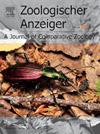A saucerful of secrets: comparative osteology of the genus Copeoglossum Tschudi, 1845 (Squamata: Scincidae) reveals a new species from Central Brazil
IF 1.5
3区 生物学
Q2 ZOOLOGY
引用次数: 0
Abstract
The genus Copeoglossum is widely distributed throughout much of the Amazon basin and other regions of central, northern, and eastern South America, including Brazil, Bolivia, Colombia, Ecuador, Peru, Venezuela, Guyana, French Guiana, and Suriname. It also occurs in the Lesser Antilles (Redonda, St. Vincent, the Grenadines, Grenada, Trinidad and Tobago). Despite the recent increase in molecular and taxonomic studies on Neotropical skinks, populations of Copeoglossum in northern and eastern South America remain understudied. Here, we examined 380 specimens from 64 localities, representing all currently recognized taxa of the genus Copeoglossum. Specimen preparation included dry skull, clearing and staining, X-ray, and high-resolution computed tomography (μCT). This study provides a detailed anatomical reference for the adult skull of species in the genus Copeoglossum, emphasizing osteological features that may aid in delineating robust species boundaries. Our findings support the recognition of a distinct lineage that does not currently have a formal name (though it has been previously identified in other studies), which we describe herein as a new species based on both cranial osteology and external morphology, as well as molecular evidence. This newly recognized species appears to be endemic to the Cerrado ecoregion, also occurring in transitional areas of Brazil's central-western region.
一碟秘密:1845年Copeoglossum Tschudi属的比较骨学(鳞片目:鳞片科)揭示了来自巴西中部的一个新种
Copeoglossum属广泛分布在亚马逊河流域的大部分地区以及南美洲中部、北部和东部的其他地区,包括巴西、玻利维亚、哥伦比亚、厄瓜多尔、秘鲁、委内瑞拉、圭亚那、法属圭亚那和苏里南。它也发生在小安的列斯群岛(雷东达、圣文森特、格林纳丁斯、格林纳达、特立尼达和多巴哥)。尽管最近对新热带石龙子的分子和分类研究有所增加,但对南美北部和东部的Copeoglossum种群的研究仍然不足。本文对来自64个地区的380个标本进行了研究,这些标本代表了目前已知的所有Copeoglossum属分类群。标本制备包括干颅骨、清除和染色、x线和高分辨率计算机断层扫描(μCT)。本研究为Copeoglossum属物种的成年颅骨提供了详细的解剖学参考,强调了可能有助于描绘强健物种边界的骨学特征。我们的研究结果支持对一个目前没有正式名称的独特谱系的认识(尽管它已经在其他研究中被确定),我们在此将其描述为基于颅骨学和外部形态学以及分子证据的新物种。这种新发现的物种似乎是塞拉多生态区特有的,也出现在巴西中西部地区的过渡地区。
本文章由计算机程序翻译,如有差异,请以英文原文为准。
求助全文
约1分钟内获得全文
求助全文
来源期刊

Zoologischer Anzeiger
生物-动物学
CiteScore
2.80
自引率
7.10%
发文量
75
审稿时长
>12 weeks
期刊介绍:
Zoologischer Anzeiger - A Journal of Comparative Zoology is devoted to comparative zoology with a special emphasis on morphology, systematics, biogeography, and evolutionary biology targeting all metazoans, both modern and extinct. We also consider taxonomic submissions addressing a broader systematic and/or evolutionary context. The overall aim of the journal is to contribute to our understanding of the organismic world from an evolutionary perspective.
The journal Zoologischer Anzeiger invites suggestions for special issues. Interested parties may contact one of the editors.
 求助内容:
求助内容: 应助结果提醒方式:
应助结果提醒方式:


